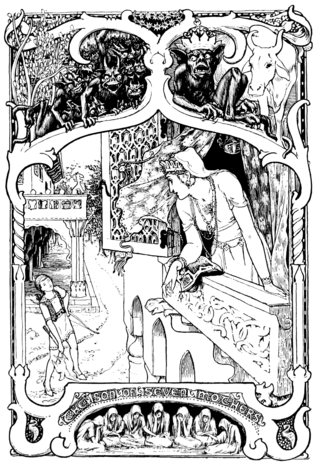Synopsis
A king's beautiful daughter vanished without a trace. The king proclaimed that whoever returned with her could marry her.
Near, a peasant couple had three sons; the older two were indulged, and the youngest always had to give way to his brothers. The oldest set out to seek his fortune. He refused food to two beggars and threw stones at birds that looked for crumbs. He went to sleep in a cave, but an ogress returned. She agreed to let him stay only if he would do a task in the morning, and then she set him to sweep out the cave. The dirt would not move, and the ogress hit him over the head, killing him. And the second brother followed and met the same fate.
The parents continued to mistreat their youngest, so he also set out. He gave some food to the first beggar, who told him to call his name, Tritill, if he needed help, and the same with the second, Litill, and he crumbed some of his bread for the birds, who also told him to call for help. He found the same cave and realized from bones and scraps of cloth that it was an ogress's lair, but remained. When she set him to sweep the floor, he called on Tritill, who did it for him.
The next day, the ogress set him to spread the feathers from her pillows to dry them and put them all back. He spread them out, a breeze carried them off, and he called on Tritill, Litill, and the birds. They put the feathers back.
The next day, the ogress set him to slaughter one of her fifty oxen, but she would not tell him which one. He called on Tritill and Litill, who slaughtered one and told him to ask for what lay on the bed, the chest at her bed's foot, and what lay under the cave's side. These proved to be the princess, a chest filled with gold and jewels, and a magical ship that moved over land and sea. He brought this all to the king, who agreed to the marriage.
The Red Ettin or The Red Etin is a fairy tale collected by Joseph Jacobs. It was included by Andrew Lang in The Blue Fairy Book.

"The Blue Bird" is a French literary fairy tale by Madame d'Aulnoy, published in 1697. An English translation was included in The Green Fairy Book, 1892, collected by Andrew Lang.
Snow-White-Fire-Red (Bianca-comu-nivi-russa-comu-focu) is a Sicilian fairy tale collected by Giuseppe Pitre and translated by Thomas Frederick Crane in Italian Popular Tales.
The Fair Fiorita is an Italian fairy tale collected by Thomas Frederick Crane in Italian Popular Tales. Italo Calvino included a variant of it, The Princesses Wed to the First Passer-By, in his Italian Folktales.
Jackal or Tiger? is an Indian fairy tale. Andrew Lang included it in The Olive Fairy Book.

"The Water of Life" is a German fairy tale collected by the Brothers Grimm, tale number 97.

Finette Cendron is a French literary fairy tale written by Madame d'Aulnoy.
The Prince Who Wanted to See the World is a Portuguese fairy tale, collected first by Portuguese writer Theophilo Braga. Andrew Lang included it in The Violet Fairy Book.
How the Beggar Boy turned into Count Piro is an Italian fairy tale collected by Laura Gonzenbach in Sicilianische Märchen. Andrew Lang included it in The Crimson Fairy Book.
Geirlug The King's Daughter is an Icelandic fairy tale collected in Neuisländischen Volksmärchen. Andrew Lang included it in The Olive Fairy Book.

The Greek Princess and the Young Gardener is an Irish fairy tale collected by Patrick Kennedy in Fireside Stories of Ireland. Joseph Jacobs included it in More Celtic Fairy Tales.
The King of Love is an Italian fairy tale from Sicily collected by Giuseppe Pitre and translated into English by Thomas Frederick Crane in Italian Popular Tales.

The legend of The Twelve Sisters or The Twelve Ladies, known as Nang Sip Song (นางสิบสอง) or as Phra Rot Meri (พระรถเมรี) in Thai and រឿងភ្នំនាងកង្រី Puthisen Neang KongRei in Cambodia, is a Southeast Asian folktale, and also an apocryphal Jātaka Tale, the Rathasena Jātaka of the Paññāsa Jātaka collection. It is one of the stories of the previous lives of Shakyamuni Buddha in which Rathasena, the son of one of the twelve women, is the bodhisattva.
The Golden Root or The Golden Trunk is a literary fairy tale written by Giambattista Basile in the Pentamerone, as the fourth story of the fifth day. It is considered to be one of two rewritings of the Graeco-Roman myth of "Cupid and Psyche" by Basile, the other being "Lo Catenaccio".
The Horse-Devil and the Witch or The Horse-Dew and the Witch is a Turkish fairy tale first collected by Hungarian Turkologist Ignác Kúnos in late 19th century.
The Hedgehog, the Merchant, the King and the Poor Man is a Hungarian fairy tale collected by László Merényi and translated by folklorist Jeremiah Curtin.
Der Sohn der Teriel is a Berber folktale, first collected in Kabylia in German by ethnologist Leo Frobenius and published in 1922.

The Son of Seven Mothers or The Son of Seven Queens is an Indian folktale, first published in the late 19th century by author Flora Annie Steel. It is classified in the international Aarne-Thompson-Uther Index as ATU 462, "The Outcast Queens and the Ogress Queen".
The Little Crab is a Modern Greek folktale translated and published by Greek folklorist Georgios A. Megas from a source in Siteia, in 1938.
The Fan of Patience is a Pakistani fairy tale from Punjab, published by Pakistani author Shafi Aqeel and translated into English by writer Ahmad Bashir.
This page is based on this
Wikipedia article Text is available under the
CC BY-SA 4.0 license; additional terms may apply.
Images, videos and audio are available under their respective licenses.





